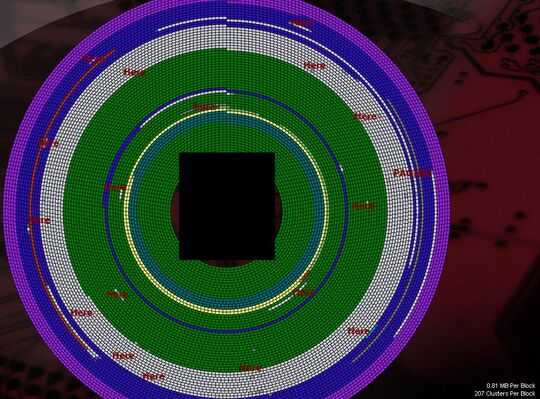7
1
C:\$extend\$Usn.Jrnl:$J:$data
Here is a picture finally. The large strip in the center of the top band is the largest chunk, in the other, grey areas are the various clusters with it.
On the right, the big long grey line is $logfile (not paging), and it is 63&nbsb;MB. Paging, 500&nbsb;MB is the dark cyan chunk, next to the yellow MFTres in the inner rings.. The disk was defragged so they could be seen easier. Not all clusters of this type of file are tagged, but the idea is there.
The disk is 4k clusters, now about 12 GB size. Each cute little block in the picture is .81 MB and represents 207 clusters. The dkGreen section, is mostly the whole Winsxs pile, also interesting when they keep telling us it doesn't take much disk space.
Wikipedia suggests that in previous NT systems "USN journaling" would be turned on when enabled (assumes it could also be turned off?).
What aspects, services, or program is working on putting that stuff all over the disk which is known by $jrnl$ type clusters, even if it is not actual USN journaling?
Is it possible in a Windows 7 system to completly disable the journaling, and what would be the ramifications of that?
On a Windows XP NTFS system, I do not recall seeing the quantity of disk clusters used with these $jrnl$ names, so I do not recall this being necessary in this quantity for an NTFS file system itself?
I understand that it would not be there, if it did not have a useful function :-) Information about how wonderful is fine, if that information will help track down what parts of the system create and use it.
Change Journals states:
Change journals are also needed to recover file system indexing
Hmm, that might explain some of them, or why it was left on the disk. A crash while background indexing?

There are many reasons for the more journal entries. One can be if the disk is being accessed more, this is very possible with Windows 7 over XP. How much RAM do you have in this system, check to see the number of background tasks that are running for all users and post that as well. How much space / clusters are being taken up by $jrnl$ clusters in 7 and if you looked at XP, please post for comparisons sake. – Dustin G. – 2011-10-09T00:17:49.663
What application were you using when you saw "crap everywhere"? and could you describe this crap? or is it just the $jrnl$ stuff? – Dustin G. – 2011-10-09T14:10:08.750
Those super duper defrag utilities don't do a whole lot for you except keep people with OCD up at night when they find that one cluster just didn't move into an "optimal" location. With files of that size, you're not going to see any performance penalties even if they are blocking a larger file from being contiguous. Using a third-party defragmenting utility isn't as beneficial as it was 7-10 years ago. Look at the pretty colors while it runs and don't waste your time worrying about the little things... – Dustin G. – 2011-10-10T06:01:52.330
2 true. I can just get a SSD and be done with it. Look at this pic http://s1107.photobucket.com/albums/h400/Psycogeec/?action=view%C2%A4t=MyD-DiskD.gif#%21oZZ3QQcurrentZZhttp%3A%2F%2Fs1107.photobucket.com%2Falbums%2Fh400%2FPsycogeec%2F%3Faction%3Dview%26current%3DMyD-DiskG.gif Does it seem like the system is doing things the way I want? I was going to process those 1 million pics, and I was also going to be storing more video data on that disk, that needs sequentiality.
– Psycogeek – 2011-10-10T17:45:09.227I removed my comments to the question itself (picture). Sometimes this kind of information is useful beyond the Psudo performace , to understanding what is going on , what breaks and how . . . did I break it :-) – Psycogeek – 2011-10-12T04:19:19.943
The level of fragmentation on this drive is fine. You will not notice any performance gains by having all files 100% sequential, even if it was video... now if a video was broken up into several hundred fragments... then you might want to clean it up. – Dustin G. – 2011-10-13T04:29:59.707